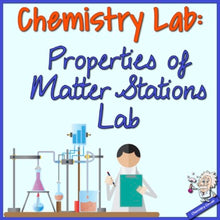In this stations lab students will identify properties of matter, and compare physical and chemical properties and changes. There are eight stations included. The lab can be run as a two-day lab, or a one-day block lab. If you only want to spend one day, you can choose four or five stations to use for your lab. Everything is editable to add to your flexibility!
This is a great first of the year lab, and appropriate for middle school and high school students. A couple of the stations may not be suitable for middle school, but you have many to choose from! The teacher notes include step-by-step instructions for setting up each station along with discussion of student misconceptions that are addressed and expected student outcome.
The Eight Stations:
Conservation of Mass
How Many Physical Properties Can You List?
Measuring Water
The Scientific Methods
Can a Metal Burn?
Mystery Metal
Physical or Chemical
Graphing Density
Lesson Objectives:
* Determine if a physical or chemical change has occurred
* Was the Law of Conservation of Mass conserved?
* Identify dissolving as a physical change
* Define dissolving, insoluble, solubility, immiscible, density, and diffusion
* Describe how changing volume or mass of a substance does not change its density
* Conclude the density of water
* Form a hypothesis
* Produce a well-constructed graph
* Write a conclusion
* Identify the independent and dependent variable
* Differentiate between qualitative and quantitative physical properties
* Produce particle drawings of a chemical change
* Identify a substance based on its density
* Calculate and graph density
Prior Knowledge:
Physical and chemical properties and changes of matter
Teacher Prep Time:
Lab set up is moderate – not complicated
Lesson Duration: One – two class periods
Included in This Resource:
* Station Student Directions (8) print & editable
* Student Lab Report w/KEY (5 pages) print & editable
* Lab
Quiz w/KEY print & editable
* Characteristics of a Well-Constructed Graph info handout print & editable
* Teacher Notes (8 pages) Compete step-by-step instructions for each station.
* Complete Materials List
This lesson is appropriate for grades 9-12 chemistry, physical science, and most stations are appropriate for middle school students.
You will want to save this lab and use it for years to come!
Chemistry Corner
Check out these other products that you may be interested in:
Chemistry: Physical & Chemical Properties and Changes of Matter
Classification of Matter
Introduction to Chemistry
Chemistry Doodle Notes for the Year: A Growing Bundle
High School Chemistry Year Curriculum – A Growing Bundle
*************************************************************************************
LICENSING TERMS: By downloading this product, you own a license for one teacher only for personal use in your classroom. Licenses are non-transferable, meaning they cannot be passed from one teacher to another. No part of this resource is to be shared with colleagues or used by an entire grade level, school, or district without purchasing the proper number of licenses. I you are a coach, principal or district interested in transferable licenses to accommodate yearly staff changes, please contact Chemistry Corner.
COPYRIGHT TERMS: ©Chemistry Corner™. Please note – all material included in this resource belongs to Chemistry Corner. By downloading, you have a license to use the material, but you do not own the material. This resource, or any portion of this resource, may not be uploaded to the internet in any form, including classroom/personal websites or network drives, unless the site is password protected and can only be accessed by students—no other teachers or anyone else on the internet.








